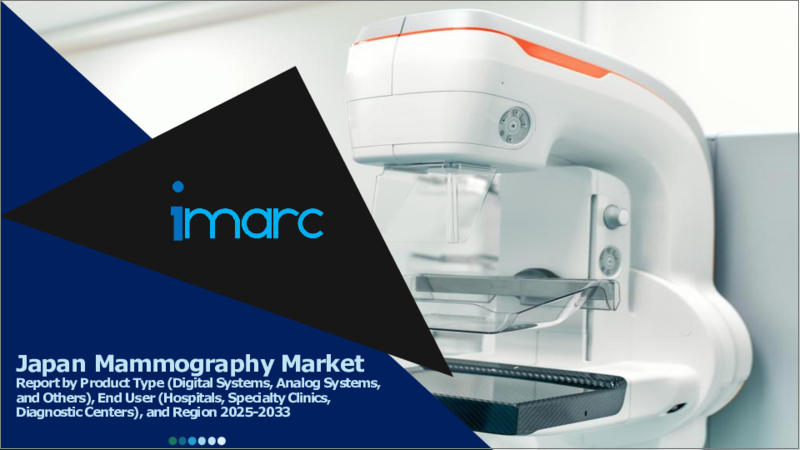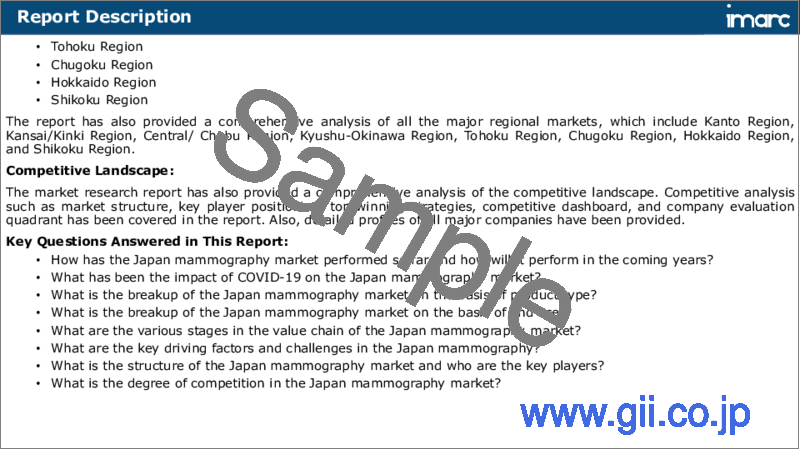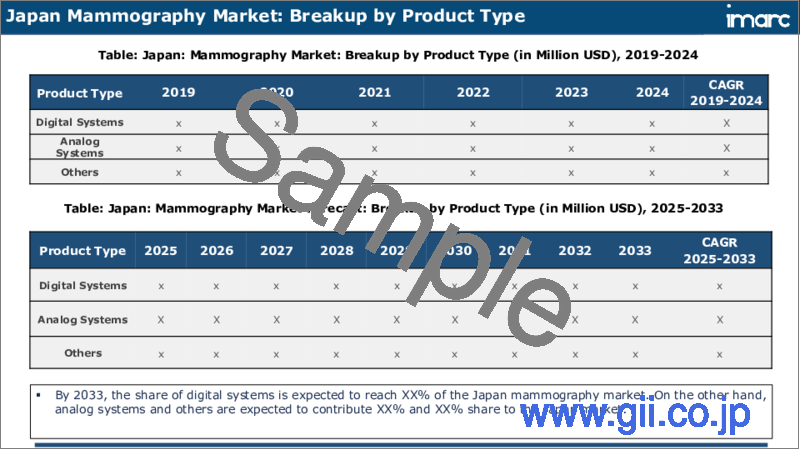|
|
市場調査レポート
商品コード
1609909
日本のマンモグラフィ市場レポート:製品タイプ、エンドユーザー、地域別、2025年~2033年Japan Mammography Market Report by Product Type (Digital Systems, Analog Systems, and Others), End User (Hospitals, Specialty Clinics, Diagnostic Centers), and Region 2025-2033 |
||||||
カスタマイズ可能
|
|||||||
| 日本のマンモグラフィ市場レポート:製品タイプ、エンドユーザー、地域別、2025年~2033年 |
|
出版日: 2024年12月05日
発行: IMARC
ページ情報: 英文 119 Pages
納期: 5~7営業日
|
- 全表示
- 概要
- 目次
日本のマンモグラフィ市場の市場規模は2024年に1億1,630万米ドルに達しました。今後、IMARC Groupは、市場は2033年までに2億4,230万米ドルに達し、2025年から2033年にかけて8.1%の成長率(CAGR)を示すと予測しています。乳がんの早期診断に対する患者の意識の高まり、政府の支援、人口動態の変化、ヘルスケア提供の進化が主に市場成長を後押ししています。
本レポートで扱う主な質問
- 日本のマンモグラフィ市場はこれまでどのように推移し、今後どのように推移するのか?
- 日本のマンモグラフィ市場にCOVID-19が与えた影響は?
- 日本のマンモグラフィ市場の製品タイプ別の内訳は?
- 日本のマンモグラフィ市場のエンドユーザー別の内訳は?
- 日本のマンモグラフィ市場のバリューチェーンにはどのような段階がありますか?
- 日本のマンモグラフィにおける主な促進要因と課題は何ですか?
- 日本のマンモグラフィ市場の構造と主要プレーヤーは?
- 日本のマンモグラフィ市場における競合の程度は?
目次
第1章 序文
第2章 調査範囲と調査手法
- 調査の目的
- ステークホルダー
- データソース
- 市場推定
- 調査手法
第3章 エグゼクティブサマリー
第4章 日本のマンモグラフィ市場:イントロダクション
- 概要
- 市場力学
- 業界動向
- 競合情報
第5章 日本のマンモグラフィ市場情勢
- 過去および現在の市場動向(2019年~2024年)
- 市場予測(2025-2033)
第6章 日本のマンモグラフィ市場:製品タイプ別の内訳
- デジタルシステム
- アナログシステム
- その他
第7章 日本のマンモグラフィ市場:エンドユーザー別の内訳
- 病院
- 専門クリニック
- 診断センター
第8章 日本のマンモグラフィ市場:競合情勢
- 概要
- 市場構造
- 市場プレーヤーのポジショニング
- 主要成功戦略
- 競合ダッシュボード
- 企業評価象限
第9章 主要企業のプロファイル
第10章 日本のマンモグラフィ市場:業界分析
- 促進要因・抑制要因・機会
- ポーターのファイブフォース分析
- バリューチェーン分析
第11章 付録
Japan mammography market size reached USD 116.3 Million in 2024. Looking forward, IMARC Group expects the market to reach USD 242.3 Million by 2033, exhibiting a growth rate (CAGR) of 8.1% during 2025-2033. The increasing awareness among patients towards early diagnosis of breast cancer, government support, demographic changes, and the evolving landscape of healthcare delivery are primarily augmenting the market growth.
Mammography is a non-invasive medical imaging and diagnostic procedure that employs low-dose X-rays to examine breast tissues for the presence of malignant tumor cells. This medical examination, commonly known as a mammogram, utilizes various systems including analog, digital, computer-aided detection, and tomosynthesis to detect and highlight small tumors, cysts, and other irregularities within the breast tissue. Screening mammography is employed to proactively search for abnormalities even in the absence of noticeable symptoms, facilitating the early identification and treatment of potentially serious medical conditions. Typically, it is followed by a diagnostic mammogram to assess any unusual clinical findings. Consequently, mammography finds wide-ranging applications in diverse healthcare settings, including hospitals, specialized clinics, and diagnostic as well as ambulatory surgical centers.
Japan Mammography Market Trends:
The Japan mammography market is a pivotal component of the country's healthcare system, characterized by a blend of technological advancements, evolving demographics, and a growing emphasis on preventive healthcare. Breast cancer awareness campaigns have led to increased awareness among women in Japan, prompting a higher demand for mammography screenings. Early detection is seen as crucial in improving treatment outcomes, driving the market's growth. Apart from this, the introduction of digital mammography, which offers superior image quality, lower radiation exposure, and efficient storage and retrieval of patient data, is also positively influencing the regional market. Furthermore, government bodies have introduced initiatives to promote breast cancer screening, including subsidies and awareness campaigns. These efforts aim to increase the number of women undergoing regular mammograms. Moreover, the COVID-19 pandemic accelerated the adoption of telemedicine and remote consultations in Japan. This includes remote radiology consultations for mammogram results, providing convenience and reducing the need for in-person visits. The elevating focus on patient-centric care is driving the demand for more comfortable and less intimidating mammography equipment, which is expected to bolster the regional market over the forecasted period.
Japan Mammography Market Segmentation:
Product Type Insights:
- Digital Systems
- 2D Mammography System
- 3D Mammography System
- Analog Systems
- Others
End User Insights:
- Hospitals
- Specialty Clinics
- Diagnostic Centers
Competitive Landscape:
The market research report has also provided a comprehensive analysis of the competitive landscape. Competitive analysis such as market structure, key player positioning, top winning strategies, competitive dashboard, and company evaluation quadrant has been covered in the report. Also, detailed profiles of all major companies have been provided.
Key Questions Answered in This Report:
- How has the Japan mammography market performed so far and how will it perform in the coming years?
- What has been the impact of COVID-19 on the Japan mammography market?
- What is the breakup of the Japan mammography market on the basis of product type?
- What is the breakup of the Japan mammography market on the basis of end user?
- What are the various stages in the value chain of the Japan mammography market?
- What are the key driving factors and challenges in the Japan mammography?
- What is the structure of the Japan mammography market and who are the key players?
- What is the degree of competition in the Japan mammography market?
Table of Contents
1 Preface
2 Scope and Methodology
- 2.1 Objectives of the Study
- 2.2 Stakeholders
- 2.3 Data Sources
- 2.3.1 Primary Sources
- 2.3.2 Secondary Sources
- 2.4 Market Estimation
- 2.4.1 Bottom-Up Approach
- 2.4.2 Top-Down Approach
- 2.5 Forecasting Methodology
3 Executive Summary
4 Japan Mammography Market - Introduction
- 4.1 Overview
- 4.2 Market Dynamics
- 4.3 Industry Trends
- 4.4 Competitive Intelligence
5 Japan Mammography Market Landscape
- 5.1 Historical and Current Market Trends (2019-2024)
- 5.2 Market Forecast (2025-2033)
6 Japan Mammography Market - Breakup by Product Type
- 6.1 Digital Systems
- 6.1.1 Overview
- 6.1.2 Historical and Current Market Trends (2019-2024)
- 6.1.3 Market Segmentation
- 6.1.3.1 2D Mammography System
- 6.1.3.2 3D Mammography System
- 6.1.4 Market Forecast (2025-2033)
- 6.2 Analog Systems
- 6.2.1 Overview
- 6.2.2 Historical and Current Market Trends (2019-2024)
- 6.2.3 Market Forecast (2025-2033)
- 6.3 Others
- 6.3.1 Historical and Current Market Trends (2019-2024)
- 6.3.2 Market Forecast (2025-2033)
7 Japan Mammography Market - Breakup by End User
- 7.1 Hospitals
- 7.1.1 Overview
- 7.1.2 Historical and Current Market Trends (2019-2024)
- 7.1.3 Market Forecast (2025-2033)
- 7.2 Specialty Clinics
- 7.2.1 Overview
- 7.2.2 Historical and Current Market Trends (2019-2024)
- 7.2.3 Market Forecast (2025-2033)
- 7.3 Diagnostic Centers
- 7.3.1 Overview
- 7.3.2 Historical and Current Market Trends (2019-2024)
- 7.3.3 Market Forecast (2025-2033)
8 Japan Mammography Market - Competitive Landscape
- 8.1 Overview
- 8.2 Market Structure
- 8.3 Market Player Positioning
- 8.4 Top Winning Strategies
- 8.5 Competitive Dashboard
- 8.6 Company Evaluation Quadrant
9 Profiles of Key Players
- 9.1 Company A
- 9.1.1 Business Overview
- 9.1.2 Product Portfolio
- 9.1.3 Business Strategies
- 9.1.4 SWOT Analysis
- 9.1.5 Major News and Events
- 9.2 Company B
- 9.2.1 Business Overview
- 9.2.2 Product Portfolio
- 9.2.3 Business Strategies
- 9.2.4 SWOT Analysis
- 9.2.5 Major News and Events
- 9.3 Company C
- 9.3.1 Business Overview
- 9.3.2 Product Portfolio
- 9.3.3 Business Strategies
- 9.3.4 SWOT Analysis
- 9.3.5 Major News and Events
- 9.4 Company D
- 9.4.1 Business Overview
- 9.4.2 Product Portfolio
- 9.4.3 Business Strategies
- 9.4.4 SWOT Analysis
- 9.4.5 Major News and Events
- 9.5 Company E
- 9.5.1 Business Overview
- 9.5.2 Product Portfolio
- 9.5.3 Business Strategies
- 9.5.4 SWOT Analysis
- 9.5.5 Major News and Events
10 Japan Mammography Market - Industry Analysis
- 10.1 Drivers, Restraints, and Opportunities
- 10.1.1 Overview
- 10.1.2 Drivers
- 10.1.3 Restraints
- 10.1.4 Opportunities
- 10.2 Porters Five Forces Analysis
- 10.2.1 Overview
- 10.2.2 Bargaining Power of Buyers
- 10.2.3 Bargaining Power of Suppliers
- 10.2.4 Degree of Competition
- 10.2.5 Threat of New Entrants
- 10.2.6 Threat of Substitutes
- 10.3 Value Chain Analysis





